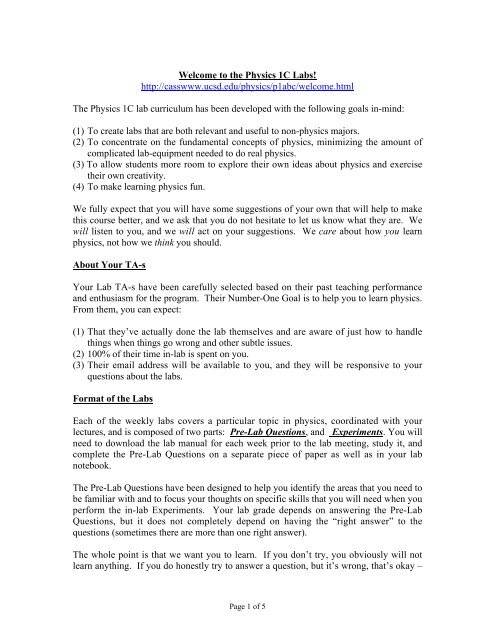1c lab syllabus - CASS
1c lab syllabus - CASS
1c lab syllabus - CASS
Create successful ePaper yourself
Turn your PDF publications into a flip-book with our unique Google optimized e-Paper software.
Welcome to the Physics 1C Labs!<br />
http://casswww.ucsd.edu/physics/p1abc/welcome.html<br />
The Physics 1C <strong>lab</strong> curriculum has been developed with the following goals in-mind:<br />
(1) To create <strong>lab</strong>s that are both relevant and useful to non-physics majors.<br />
(2) To concentrate on the fundamental concepts of physics, minimizing the amount of<br />
complicated <strong>lab</strong>-equipment needed to do real physics.<br />
(3) To allow students more room to explore their own ideas about physics and exercise<br />
their own creativity.<br />
(4) To make learning physics fun.<br />
We fully expect that you will have some suggestions of your own that will help to make<br />
this course better, and we ask that you do not hesitate to let us know what they are. We<br />
will listen to you, and we will act on your suggestions. We care about how you learn<br />
physics, not how we think you should.<br />
About Your TA-s<br />
Your Lab TA-s have been carefully selected based on their past teaching performance<br />
and enthusiasm for the program. Their Number-One Goal is to help you to learn physics.<br />
From them, you can expect:<br />
(1) That they’ve actually done the <strong>lab</strong> themselves and are aware of just how to handle<br />
things when things go wrong and other subtle issues.<br />
(2) 100% of their time in-<strong>lab</strong> is spent on you.<br />
(3) Their email address will be avai<strong>lab</strong>le to you, and they will be responsive to your<br />
questions about the <strong>lab</strong>s.<br />
Format of the Labs<br />
Each of the weekly <strong>lab</strong>s covers a particular topic in physics, coordinated with your<br />
lectures, and is composed of two parts: Pre-Lab Questions, and Experiments. You will<br />
need to download the <strong>lab</strong> manual for each week prior to the <strong>lab</strong> meeting, study it, and<br />
complete the Pre-Lab Questions on a separate piece of paper as well as in your <strong>lab</strong><br />
notebook.<br />
The Pre-Lab Questions have been designed to help you identify the areas that you need to<br />
be familiar with and to focus your thoughts on specific skills that you will need when you<br />
perform the in-<strong>lab</strong> Experiments. Your <strong>lab</strong> grade depends on answering the Pre-Lab<br />
Questions, but it does not completely depend on having the “right answer” to the<br />
questions (sometimes there are more than one right answer).<br />
The whole point is that we want you to learn. If you don’t try, you obviously will not<br />
learn anything. If you do honestly try to answer a question, but it’s wrong, that’s okay –<br />
Page 1 of 5
now you know that you need to have your <strong>lab</strong> partners or your TA explain it to you.<br />
Don’t leave the <strong>lab</strong> until you’ve demonstrated to your TA that you’ve learned the<br />
material. He or she will sign your <strong>lab</strong> notebook before you leave the <strong>lab</strong> as your record<br />
that you’ve learned what you need to.<br />
You will work in groups of four students per <strong>lab</strong>-table, with students rotating from groupto-group<br />
on a weekly basis. Everybody will have some important role to play as part of a<br />
team conducting the experiments, collecting data and analyzing results as a group. There<br />
is no formal <strong>lab</strong> write-up. It’s up to you and your group as to how best present your<br />
results. This is an environment of open discussion and problem-solving where you are<br />
free to explore your own questions as you discover them.<br />
What you will need to bring to each <strong>lab</strong> (required)<br />
! A quad-ruled notebook containing your completed Pre-Lab Questions (See<br />
Page 4).<br />
! A copy of the <strong>lab</strong> manual for each weekly experiment.<br />
! A scientific calculator, pencil and eraser.<br />
! A copy of Hecht (helps to look-up information that you didn’t anticipate<br />
needing, not required, but often useful.)<br />
Grading<br />
Your <strong>lab</strong> grade is weighted at 20% of your total course grade. Lab grading is done in-<strong>lab</strong><br />
by the end of each experiment. Your TA will visit each group of students and check their<br />
work as the <strong>lab</strong> progresses. You will generally find that your colleagues have helped to<br />
clarify any pre-<strong>lab</strong> questions that you may have had difficulty with before your TA<br />
comes-around. It’s okay to answer a question again (don’t erase an answer that you got<br />
wrong – wrong answers show us where we need to improve – write your new answer<br />
along with it.) And don’t just copy something you don’t understand – have the TA<br />
explain it to you if your colleagues’ answers aren’t making things absolutely clear to you<br />
(They won’t be around when you take your quizzes, midterm and your final, so if you<br />
don’t truly understand some question, don’t let your TA off-the-hook by not asking.<br />
You’ll only be sorry later.)<br />
Your <strong>lab</strong> grade consists of two parts. Students will receive a maximum of five points per<br />
<strong>lab</strong>, with two points allocated to the pre-<strong>lab</strong> homework and three points allocated to in<strong>lab</strong><br />
work.<br />
Your pre-<strong>lab</strong> homework is to be turned in at the beginning of the <strong>lab</strong>. Only handwritten<br />
homework will be accepted. Full credit will be awarded for students correctly solving the<br />
pre-<strong>lab</strong> homework. Partial credit will be given, so it is in your interest to attempt all pre<strong>lab</strong><br />
homework problems.<br />
The in-<strong>lab</strong> experiments will contain both quantitative and qualitative procedures.<br />
Experiments requiring quantitative data and calculations must be clearly presented,<br />
including explicit calculations, data tables, and graphs when appropriate. Experiments<br />
Page 2 of 5
equiring qualitative observations must show reasoned attempts at explanations of<br />
observed phenomena in addition to the observations themselves.<br />
Missing a Lab and Make-up Labs<br />
You should avoid considering a make-up <strong>lab</strong> unless you find yourself in a position with<br />
no other options. The reasons are these: First, the <strong>lab</strong>s have been shown to help on<br />
weekly lecture quizzes (miss your <strong>lab</strong>—miss your advantage, so to speak.) Second,<br />
make-up <strong>lab</strong>s will only be given during Week-10. This will not allow you to do more<br />
than one <strong>lab</strong>, so you should save this option for unanticipated events that may come-up<br />
later in the quarter when you really need it. In the rare event that you absolutely must<br />
miss a <strong>lab</strong>, email your Lab Instructor immediately to make arrangements for 10 th week.<br />
Contacts<br />
Your principal contact for your <strong>lab</strong> course is your <strong>lab</strong> TA. They should be able to handle<br />
all of your questions regarding your <strong>lab</strong> course. However, if circumstances arise for<br />
which you need other avenues of support, the following outline of contacts is included:<br />
! Contact your Lab TA for questions concerning:<br />
• Grading of your <strong>lab</strong>s.<br />
• Things not clear to you in the <strong>lab</strong> manuals.<br />
• Extra help with the subject matter.<br />
! Contact your Lab Instructor (Daniel Queen dqueen@ucsd.edu) for any of the<br />
following:<br />
• Questions that your TA can’t answer.<br />
• Missing a <strong>lab</strong> and scheduling a make-up <strong>lab</strong>.<br />
• Suggestions for improvements to the curriculum.<br />
• Complaints about TA perfomance or behavior.<br />
! Contact the Lecture Professor (Dr. Tytler, dtytler@ucsd.edu) for:<br />
• Anything not satisfactorily handled above.<br />
• Complaints about your Lab Instructor.<br />
Page 3 of 5
Lab Schedules<br />
Weekly Schedule of Physics 1C Lab Experiments<br />
Week Lab Title References<br />
1 NO LABS Hecht Chapter 24<br />
2 Reflection and Refraction of Light Hecht Chapter 25<br />
3 Lenses, Mirrors and Images Hecht Chapter 26<br />
4 Optical Instruments and the Eye Hecht Chapter 27<br />
5 Diffraction and Interference Hecht Chapter 28<br />
6 Polarization Hecht Chapter 29<br />
7 Speed of Light Hecht Chapter 30<br />
8 Optical Spectroscopy Hecht Chapter 31<br />
9 Radioactivity Hecht Chapter 32<br />
10 MAKE-UP LABS Hecht Chapter 33<br />
11 FINALS WEEK – NO LABS<br />
Quad-Ruled Notebook<br />
The term is often unfamiliar, so we’ll clarify a little more: The<br />
notebook that you want is like one of those medium-sized<br />
composition books with the black-and-white marbled covers. The<br />
real key is that you want a hard-bound notebook which has<br />
graph paper pages in it (very helpful for making tables and<br />
graphs). Quad-ruled just means that the graph paper is ruled with<br />
four squares per inch. You can use five-squares-per-inch, or eightsquares-per-inch<br />
– or whatever. These things are avai<strong>lab</strong>le from a<br />
variety of places, including UCSD Bookstore. Feel free to get the<br />
least expensive one you can find. Here’s a picture of something similar to what you<br />
should look for (don’t drive yourself nuts trying to find this exact thing, that’s not<br />
necessary – just something inexpensive like it with graph paper in it):<br />
Policy for Lab Section Changes<br />
General Procedure<br />
All section changes must be handled via WebReg or the<br />
Registrar’s Office. Do not enroll in a section you cannot attend. You will only be<br />
allowed to perform the <strong>lab</strong> in your enrolled section.<br />
If you wish to switch <strong>lab</strong> sections, you must drop the section you are currently enrolled<br />
in, and add a different one, provided there is space avai<strong>lab</strong>le. This can be done via<br />
Page 4 of 5
WebReg, or in person at the Registrar’s Office using Add/Drop Cards, up to the end of<br />
the 2 nd week of classes (see also Late Adds policy below).<br />
Note that the section you are switching into must not be full. If it is, you will not be<br />
able to enroll in it. Be aware that the Schedule of Classes is only updated at night. So,<br />
even if the Schedule of Classes indicates that there is room in a section, there may<br />
not be! (This is possible if someone has already added the section early in the morning.)<br />
The Registrar’s Office maintains the most current enrollment statistics. To find out if<br />
there still is room in a section, check the StudentLink website or contact the Registrar (in<br />
person, or over the phone, 534-3150).<br />
Some students are worried that by the time they try to enroll in another section, it will<br />
already be full. The best way to avoid this is to fill out two cards: a Drop card (for the<br />
section to drop), and an Add card (for the section you want). Then, take those in person<br />
to the Registrar’s Office, and hand them in at the same time. The Registrar's Office will<br />
check to make sure the section you want has room before they make the switch.<br />
Late Adds<br />
According to the policy posted by the Registrar, you may add classes after the secondweek<br />
deadline, subject to a $3 late add fee. If you wish to add a section during the 3 rd or<br />
4 th week of classes, you must fill out an Add card, obtain a department stamp (or<br />
signature) from the Physics Dept., and then take the Add card to the Registrar’s Office.<br />
Late adds cannot be done via WebReg. (Note: you may drop a class with no penalty up<br />
to the end of the 4 th week of classes.)<br />
Wait Lists<br />
The only purpose of the wait lists is so that the department can determine if additional<br />
sections need to be created. Being on a wait list does not give students priority or even<br />
guarantee enrollment. However, should space become avai<strong>lab</strong>le in a section that you<br />
have wait-listed, you must first remove yourself from the wait list, then add that section<br />
(via WebReg/Registrar). This will not be done automatically.<br />
Page 5 of 5





